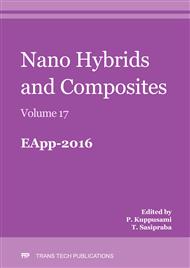p.1
p.10
p.18
p.24
p.31
p.37
p.44
p.55
Thermal Conductivity and Charging & Discharging Characteristics of a Thermal Energy Storage System Blended with Al2O3 Nanoparticles
Abstract:
Phase change material (PCM) based thermal energy storage systems (TES) are mandatoryto utilize solar energy efficiently and effectively. Paraffin is widely used phase change material and the only disadvantage with paraffin is that its poor thermal conductivity. The objective of the study is to increase the thermal conductivity of the PCM based TES. The thermal conductivity of the paraffin PCM blended with Al2O3 nanoparticle with different proportions was determined both experimentally and analytically for solid and liquid states. The different volume concentrations of Al2O3 nanoparticle blended with paraffin are 0.01, 0.02, 0.03, 0.04, 0.05 and 0.1. The charging and discharging characteristics of the thermal energy storage system was also determined for the above mentioned different volumetric concentrations of nanoparticles blended with paraffin using an experimental set up fabricated. It was found that, Al2O3 nanoparticle can be blended to maximum of 0.1% volume concentration with n-tricosane paraffin without any agglomeration. The significant improvement in thermal conductivity, charging & discharging characteristics of the thermal energy storage system was observed corresponding to this proportion of blending.
Info:
Periodical:
Pages:
10-17
Citation:
Online since:
August 2017
Authors:
Price:
Сopyright:
© 2017 Trans Tech Publications Ltd. All Rights Reserved
Share:
Citation:


